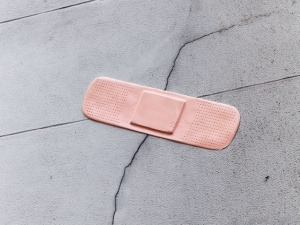Scratches in the car finish or cracks in polymer material: Self-healing materials can repair themselves by restoring their initial molecular structure after the damage. Scientists of the Karlsruhe Institute of Technology and Evonik Industries have developed a chemical crosslinking reaction that ensures good short-term healing properties of the material under mild heating. The research results have now been published in the Advanced Materials journal. DOI:10.1002/adma.201306258
The KIT group headed by Christopher Barner-Kowollik uses the possibility of crosslinking functionalized fibers or small molecules by a reversible chemical reaction for the production of self-healing materials. These so-called switchable networks can be decomposed into their initial constituents and reassembled again after the damage. The advantage is that the self-healing mechanism can be initiated any time by heat, light or by the addition of a chemical substance. “Our method does not need any catalyst, no additive is required,” Professor Barner-Kowollik says. The holder of the Chair for Preparative Macromolecular Chemistry at KIT studies syntheses of macromolecular chemical compounds.
It took about four years of research for the working group of Barner-Kowollik, together with the Project House Composites of Creavis, the strategic innovation unit of Evonik, to develop a novel polymer network. At comparably low temperatures from 50°C to 120°C, the network exhibits excellent healing properties within a few minutes. Reducing the time needed for healing and optimizing the external conditions, under which the healing process takes place, are the major challenges of research relating to self-healing materials. Using the healing cycle developed by them, the KIT researchers have found a large number of intermolecular compounds that close again within a very short term during cooling. Mechanical tests, such as tensile and viscosity tests, confirmed that the original properties of the material can be restored completely. “We succeeded in demonstrating that test specimens after first healing were bound even more strongly than before,” Barner-Kowollik says.
The self-healing properties can be transferred to a large range of plastics known. Apart from self-healing, the material is given another advantageous property: As flowability is enhanced at higher temperatures, the material can be molded well. A potential field of application lies in the production of fiber-reinforced plastics components for automotive and aircraft industries.
In the consortium developing the novel crosslinking reaction, the chemical company of Evonik is the industry partner. The research partners of KIT are the Leibniz Institute of Polymer Research, Dresden, and the Australian National University, Canberra.
Kim K. Oehlenschlaeger, Jan O. Mueller, Josef Brandt, Stefan Hilf, Albena Lederer, Manfred Wilhelm, Robert Graf, Michele L. Coote, Friedrich G. Schmidt and Christopher Barner-Kowollik: Adaptable Hetero Diels-Alder Networks for Fast Self-Healing under Mild Conditions. Advanced Materials, 2014. DOI:10.1002/adma.201306258.
The photo only serves illustration purposes on the website of KIT. The rights for use for reporting do not lie with the KIT, but with the photographer. If necessary, they may be purchased at http://de.fotolia,com/id/32406844.
Being “The Research University in the Helmholtz Association”, KIT creates and imparts knowledge for the society and the environment. It is the objective to make significant contributions to the global challenges in the fields of energy, mobility, and information. For this, about 10,000 employees cooperate in a broad range of disciplines in natural sciences, engineering sciences, economics, and the humanities and social sciences. KIT prepares its 22,800 students for responsible tasks in society, industry, and science by offering research-based study programs. Innovation efforts at KIT build a bridge between important scientific findings and their application for the benefit of society, economic prosperity, and the preservation of our natural basis of life. KIT is one of the German universities of excellence.

